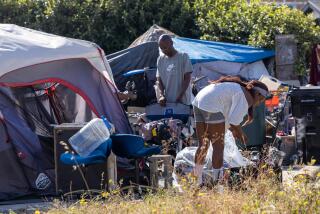Census Aims for Better Count of Homeless
- Share via
Census takers from Orange County will join thousands of others this weekend to prepare for one of the most controversial tasks of the decennial survey: counting the homeless.
Their mission is to avoid mistakes of the past.
In the 1990 population tally, only 1,882 homeless people were counted in Orange County, far below the 12,000 estimated by organizations that advocate for the homeless. The undercount, endemic throughout the nation, cost affected communities federal funding for social programs.
Census workers wearing bright orange and yellow vests, to make them appear less threatening, will fan out to shelters Monday evening, soup kitchens the following day, and to underpasses, encampments and other makeshift dwellings Tuesday night.
The vest colors, similar to what safety workers wear, were recommended by advocates for the homeless who saw the black and white version worn during the 1990 census as too ominous, a census official said.
“They are going to get a much better count than before,” predicted Judy Kampmann, executive director of Shelter for the Homeless, which is based in Midway City and runs 47 properties for homeless people. “They’ve made a point to go into the trenches. It used to be, ‘If they don’t get it in the mail, the government doesn’t get it’ and that’s it.”
But many other advocates locally and nationally said they do not expect this year’s count to be much better than the highly controversial one in 1990. That census, which reported 228,621 homeless people nationwide, with the largest number living in California, was attacked by congressional investigators in the General Accounting Office as grossly inaccurate.
In the city of Los Angeles, 7,706 were counted at shelters or on the streets in 1990, compared to homeless organization estimates of two to four times as many.
With the Census Bureau next week limiting its surveying to one day each at specific types of locations for transients and the homeless, there is little chance of most, let alone all, being surveyed, the advocates said.
“The most important thing to understand is that it’s not a [total] count,” said Mary Ann Gleason, executive director for the National Coalition for the Homeless in Washington. “They are only going to some shelters, some soup kitchens, some outdoor locations.”
The Census Bureau’s Steve Alnwick, at regional headquarters in Van Nuys, agreed. “It’s not a total picture, that’s correct,” he said. But the manner in which they count the homeless and transient populations ensures they at least get a snapshot, he said.
Ruth Schwartz of the nonprofit Shelter Partnership in downtown Los Angeles, which tallies numbers of the homeless, said she hopes future federal grants won’t rely on census figures.
One of the toughest tasks for census takers will be to overcome the distrust the homeless often have toward government agencies, said Margie Wakeham, executive director of Families Forward (formerly Irvine Temporary Housing). “Many are so transient, they won’t allow themselves to be counted at all.”
“I think if you have any government agency coming in and inquiring about your living situation, there is an anxiety that develops,” Wakeham said. “Many are so transient, they won’t allow themselves to be counted at all.”
Staff writers Annette Kondo and Mark Surman contributed to this report.
More to Read
Sign up for Essential California
The most important California stories and recommendations in your inbox every morning.
You may occasionally receive promotional content from the Los Angeles Times.










